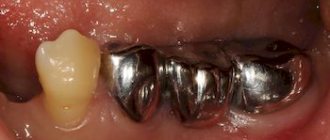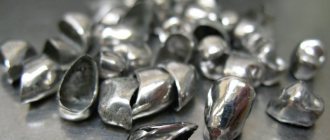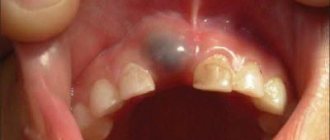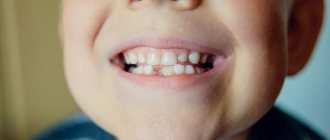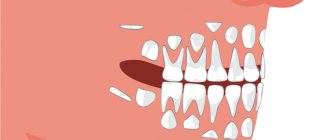Pediatric dentistry can be considered a separate section of modern dental practice, because due to the structural features, the treatment of baby teeth is somewhat different from the treatment of permanent teeth. Unfortunately, many parents are still convinced that baby teeth do not need dental care - after all, they will soon break down and fall out anyway. Therefore, children are not taken to the dentist very often, and if they are taken to the doctor, it is with advanced diseases and multiple problems.
In fact, dental treatment should be carried out at any age, and the sooner you consult a doctor with a problem, the higher the likelihood of getting rid of it quickly and without any complications. If a child has bad baby teeth, this will inevitably affect the health of his permanent ones - this is what parents need to remember when they want to “pity” the baby and not take him to an appointment with the “evil dentist.”
Gum inflammation
The most common inflammatory gum diseases in children are stomatitis and gingivitis. Stomatitis, or, as it is usually called, thrush, is an infectious inflammatory process provoked by fungi of the genus Candida. Treatment is antifungal and anti-inflammatory therapy, always carried out under the supervision and recommendations of a dentist. Self-medication can be dangerous, as some children may have allergic reactions to certain medications or antiseptics.
Gingivitis most often occurs due to plaque on baby teeth and insufficient general hygiene, but the reasons for their development can also be trauma to the gums during teething or other injuries, untreated caries. With this problem, you also need to contact a doctor, who will select the optimal treatment regimen and prevent gingivitis from developing into childhood periodontitis.
Indications and contraindications
Many parents do not want to put fillings on their children's baby teeth. They consider dental treatment to be unnecessary stress for the child, for which they also have to pay. In the understanding of adults, temporary teeth are not particularly valuable, because they will fall out anyway. In fact, the role of temporary occlusion in a child’s life is very great. Baby teeth are needed for:
- complete chewing of food;
- proper development of the jaws;
- formation of a healthy bite;
- preparing the oral cavity for the appearance of permanent units;
- developing clear diction.
Untimely treatment of caries is fraught with chronic pathologies of the digestive tract and ENT organs. Premature loss of temporary units leads to malocclusion and deformation of the dentition. Indications for filling are:
- unit destruction up to 50%;
- deep caries;
- a large reserve of time before the root unit erupts;
- enamel chips;
- the need to restore the anatomy of the crown after treatment of pulpitis or periodontitis.
Temporary units that are subject to deletion are:
- mobile;
- destroyed by more than 50%;
- will soon be replaced by permanent ones (determined by the length of the roots according to X-ray examination);
- collapsed despite previous filling.
Would you like us to call you back?
Caries, pulpitis and periodontitis of primary teeth in children
Milk teeth have thinner enamel and dentin layers than permanent teeth, they have a larger pulp chamber and, therefore, infection spreads faster to the pulp. They are more often susceptible to carious lesions - and not least because of night feeding or the habit of drinking drinks from a bottle at night (mostly sweet or sweetened - tea, juices).
In addition, caries is often provoked by plaque on baby teeth, which forms faster than in adults, and which not all parents are in a hurry to remove. Many people begin brushing their children’s teeth at a more or less conscious age, while a child should be taught hygiene and regularly remove plaque from the moment the first teeth erupt, that is, from about six months of age. Also, the cause of diseases of the dental system can be an insufficient amount of solid food in the baby’s diet, since chewing solid food helps to clean the dental surfaces themselves.
The child's nutritional habits, lack of hygiene, and too thin enamel layer provoke a phenomenon called circular caries of baby teeth - carious lesions spread over the entire tooth surface, as if encircling the crown.
Caries quickly turns into pulpitis - an inflammatory lesion of the dental pulp. Most often, a doctor is consulted precisely at this stage of the infectious process, ignoring the initial stages of damage to dental tissues. Pulpitis, in turn, provokes periodontitis of primary teeth in children - inflammation of the periodontal tissues near the tips of the tooth roots. This condition is usually accompanied by severe pain, severe swelling of the affected area, and often an increase in body temperature.
How the procedure works
Filling baby teeth is similar to filling molar teeth. The main difference is that when temporary teeth are restored, they are filled entirely: to avoid re-damage, healthy fissures are also covered with filling material. To avoid fissure caries of primary molars, dentists recommend fissure sealing as soon as teeth erupt.
Depending on the degree of caries damage and the patient’s age, the dentist chooses a treatment method:
- if the carious cavity is small, manual preparation is allowed;
- treatment of the affected area with chemicals;
- preparation using a drill.
Remember, careful care and timely treatment of temporary teeth is the key to the health of permanent teeth.
Treatment of baby teeth
At the initial stages, caries is treated without tissue preparation - remineralization of the enamel, as well as modern Icon technology, which allows filling without drilling, easily cope with carious lesions of the enamel layer. In later stages, when the dentinal layer is affected, as well as in the case of pulpitis and periodontitis, treatment of baby teeth with tissue preparation will be required. You should not be afraid of such procedures - modern methods of anesthesia allow them to be carried out completely painlessly and comfortably for a small patient. In addition, the anesthetics used are harmless, with a minimum concentration of the active substance. And the site of the upcoming injection itself is numbed by applying a special gel or spray (application anesthesia).
Experienced dentists try to carry out treatment quickly so that the child does not have time to get tired and capricious. If a child has bad baby teeth and a large amount of work is required, it is divided into several stages. It also happens that the child does not want to contact the doctor, is too afraid of treatment, or the volume of manipulation is too large and serious - in such a situation, it is possible to carry out therapy under anesthesia or with intravenous sedation (with a preliminary examination).
In case of pulpitis, the root canals are filled with special pastes that dissolve simultaneously with the “milky” root, so there is no chance that the medicinal material will remain in the tooth socket and will prevent the new tooth from growing properly.
Caring for fillings on baby teeth
After visiting the doctor, the child must be explained the importance of proper care of the filling. In the first days, you need to be careful about putting stress on the treated tooth. Dentists recommend the following to maintain the condition of teeth after filling:
- Do not give your child hot or cold food in the first few days after treatment, so as not to harm the process of the filling shrinking in the cavity and binding it to the tissues.
- Avoid giving food that is too hard or sticky.
- Conduct regular examinations of the entire oral cavity, including the unit that has been treated, and be attentive to what sensations the child experiences.
- Visit the dentist after 4 months to monitor the condition of the filling and the entire oral cavity.
- Reduce consumption of carbonated and sugary drinks to a minimum. Dilute the juice with water. Introduce more vegetables and high protein foods into your diet.
- Together with the dentist, select a suitable toothpaste and brush for the child, and undergo training in proper cleansing. Instill the habit of brushing your teeth.
- Limit the use of sticky foods, such as chewing gum.
If a baby tooth hurts after filling
, don't worry right away. Pain after treatment with extensive surgery is normal and goes away on its own within one or two days. When filling the roots, the pain may go away after two weeks. If a child has a fever or swelling in the intervention area, these are symptoms that require you to consult a doctor.
Continuing pain may indicate that adequate treatment was not carried out, the technology was violated when placing the filling material, the tooth was opened carelessly, damaging the tissue, or the treatment was not completed (in the case of canal filling). In rare cases, a child may develop an allergy to the filling material.
Restoration of baby teeth
If a child’s baby tooth breaks off or if the dental crown is severely damaged by caries, restoration is carried out. However, if for adult patients one of the most important aspects during restoration is aesthetics, then for children functionality is much more important. Therefore, restorative filling materials are always selected taking into account the patient’s age - for children, durability and impeccable aesthetics are not so important, a good marginal fit of the fillings and the preservation of dental tissues are much more important. Filling materials that are too strong can put pressure on dental tissues and contribute to their destruction, and therefore dentists choose materials that will recreate and maintain the integrity of the dental crown until the moment of natural tooth loss.
Stages of installing a light seal
Installation of a filling made of photopolymer materials includes:
- tooth treatment - the doctor removes the destroyed dentin with a dental bur, rinses and dries the resulting cavity, etches it and makes the surface rough;
- preparation for filling - dental glue is applied to the inner surface of the tooth cavity, on top of which a frame for the future filling is applied and cured;
- direct filling and molding - the dentist fixes the photopolymer in layers of 2 mm with intermediate drying. The surface layer of the filling is formed in accordance with the bite and structural features of the patient’s teeth. This is followed by final curing of the filling using a special lamp for light polymerization;
- grinding - the doctor achieves an ideal surface by polishing the filling using abrasive discs and dental rubber bands.
Teeth restored in this way are difficult to distinguish from originally healthy ones. When restoring the dental row in the smile area, our clinic uses composites, the shade of which matches the color of the patient’s enamel, and the layer-by-layer polymer application technology makes the filling translucent.
To fill cavities in chewing teeth, we use macro-filled materials that can withstand high chewing loads.
Removal of baby teeth in children
Removal of baby teeth in children is carried out only for specific indications or in the case when the tooth is ready to fall out on its own and just needs a little “help”. If there is a choice - to remove or treat, a competent dentist will always advise treatment, since the early loss of baby teeth leads to a number of serious disorders of the dental system, including the appearance of permanent bite defects.
Extraction operations should be carried out exclusively in the dentist’s office - attempts to remove teeth at home can lead to injury to soft tissues, infection of the socket, injury to the rudiment of a permanent dental unit, etc. The doctor will perform the extraction under local anesthesia quickly, competently and completely painlessly.
Advantages of SM-Dentistry
- Qualified pediatric dentists The best dentists in Moscow work here, having extensive experience in treating children. Knowing the basics of child psychology, doctors establish trusting relationships with the little patient and carry out all therapeutic and diagnostic manipulations in a playful manner. This avoids fear and stress in the child. Our dentists explain in an accessible manner the importance of treatment and teach the child how to properly perform hygiene procedures.
- Comprehensive services We monitor the oral health of our patients from the moment the first tooth appears. Regular preventive examinations make it possible to identify diseases in the early stages, when treatment can be carried out quickly and painlessly. We perform dental fillings under local anesthesia (application + injection), under sedation (if the child is anxious) or under anesthesia (if several teeth need to be treated at once). Thanks to qualified anesthesia, these procedures are absolutely safe for children.
- The best materials Doctors use advanced equipment and certified materials from world-famous manufacturers in their work. We use only those medications that are registered in our country and are absolutely safe for the youngest patients.
You can find out more details and sign up for a consultation with a specialist by calling: +7
, or by filling out the form:
What to do if baby teeth grow crookedly?
If parents notice that their child’s baby teeth are growing crookedly - for example, there is crowding or improper occlusion - this is a reason for a mandatory consultation with a pediatric orthodontist. It happens that due to anomalies of the facial skeleton (in particular, improper development of the jaws), defects are noticeable even with a primary bite, and with a permanent bite they will persist and worsen.
Therefore, it is recommended to show the child to an orthodontist from the age of three to determine whether there is pathology and find methods for its correction. There are malocclusions that are easily corrected at an early age and extremely difficult to correct in adults.
How to protect baby teeth from caries?
Prevention is the best way to cope with any disease. Therefore, those parents who care about the health of their children should definitely think about caries prevention. How to protect baby teeth from caries? The recommendations of experts in this matter are as follows:
- The correct diet for the mother during pregnancy is with a sufficient amount of foods containing calcium, fluorine and phosphorus: cottage cheese, beef and beef liver, sea fish, nuts, fruits and vegetables, cereal porridges.
- Compliance with hygiene standards: daily brushing from the moment the first teeth appear, first with a cotton or gauze swab with boiled water, then with special baby brushes and pastes. Plaque on baby teeth should be removed promptly and thoroughly.
- A healthy diet for a child: as little fast carbohydrates, carbonated drinks, sweets as possible, more fruits and vegetables, cereals, and dairy products.
- Timely visits to the dentist for preventive examinations (at least once every six months).
It is important that parents develop a conscious attitude towards the health of their children's teeth and oral cavity in general. A timely visit to the dentist in case of any identified problems, as well as for regular medical examinations, will help maintain the health of the child’s dental system – and therefore the digestive system too.
Colored fillings
Colored fillings for children are a great incentive to withstand the test of the dental chair. Fillings look interesting on teeth, delight with bright colors, and lift the spirits of children and those around them. In addition, colored fillings are of the same quality as simple fillings. They serve faithfully until the change of baby teeth.
Indications for the use of colored fillings
Colored fillings differ from simple fillings only in color, so the indications for their installation are the same. This is the presence of caries of milk teeth, pulpitis, tartar. Causes of concern are plaque, tooth mobility and early tooth loss.
The danger of primary tooth disease is that the roots of primary teeth come into contact with the buds of permanent teeth, which leads to caries and premature tooth loss.
In addition, premature loss of baby teeth leads to changes in bite, facial contour, and diction. Poor chewing of food leads to diseases of the digestive organs. A tooth with caries is a source of infection in the child’s oral cavity, which affects both the remaining teeth and internal organs, because microbes are carried throughout the body by the bloodstream. That is why dentists recommend not to ignore small defects on baby teeth, but to regularly come for preventive examinations and treat teeth from an early age.
Contraindication
A contraindication to the installation of colored fillings will be individual intolerance to individual components of the material.
What are the advantages of children's colored fillings?
Colored fillings are a psychological maneuver to distract the child’s attention from the upcoming therapeutic procedures. Choosing the color of the filling together allows the baby to be distracted, recharged with positivity and pleasant anticipation. But besides the mentioned aspect, colored fillings have practical advantages:
- They consist of a material specially designed for baby teeth.
- Colored fillings last up to 3 years, lasting until permanent teeth appear.
- A plastic filling material that allows it to fill free space, cracks, and crevices.
- High hardening speed.
- The filling is firmly attached to the tooth enamel and can withstand the stress of chewing.
- Thanks to the bright color, filling defects (chips) are immediately visible.
- The fillings contain fluoride, which prevents the development of caries. In addition, the filling absorbs fluoride from food and releases the microelement to the tooth.
- The material does not require preparation; it is placed into the tooth cavity from a special sealed capsule, which reduces the time of therapeutic operations.
- The price of colored fillings for children is almost no different from simple fillings. Prices for colored fillings vary from one dentist to another.
- Children love to look at rainbow-colored teeth in the mirror and it makes them interested in oral care.
- Colored fillings are placed on the back teeth, and traditionally colored fillings are placed on the front teeth.
Types of fillings
Colored fillings in pediatric dentistry are blue, silver, gold, orange, pink, yellow, and green. Here the choice of color depends only on the little patient. Princesses choose pink, golden, and orange fillings, and knights choose silver, green, and blue. A popular manufacturer of colored fillings is the German company VOCO. For the most part, reviews on the Internet about colored fillings and their prices are positive. Parents note that the child experiences less fear, is interested in the dental treatment process, and is more willing to take care of his teeth in the future.
Prevention of caries in children
The main way to keep teeth healthy is prevention. Therefore, you need to take care of children's teeth seriously from an early age. It is important to understand that the child is not able to take care of the oral cavity on his own, and the responsibility for this lies with the parents. Dental health is determined during the prenatal period, and the expectant mother should take vitamins containing calcium and fluoride.
You should take care of your child’s teeth from the moment the first tooth appears. It is worth purchasing a special silicone brush and age-appropriate paste, with which you can keep your mouth clean. There are a lot of tips on how to preserve your child's teeth. By adhering to the recommendations, parents lay a reliable foundation for the child’s health.




